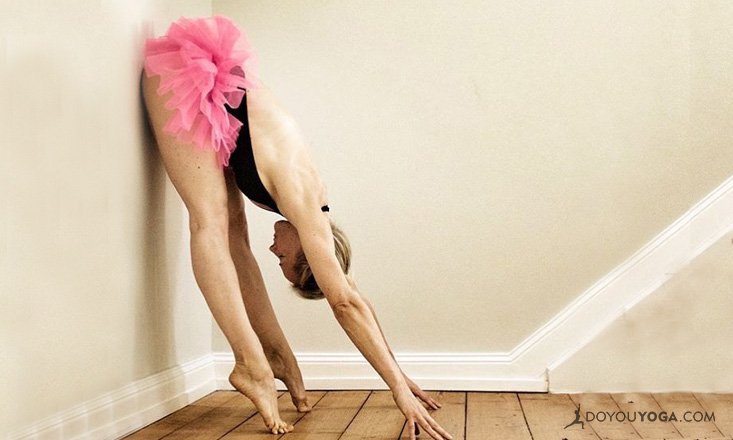Whether practicing at home or in a class, it’s always fun to experiment with props and new ways to enhance or support your yoga poses. Adding extra bits and pieces can be a really fun way to expand your practice and push your limits.
Ways to use a wall to support your practice.
Keeping flexibility, strength and balance in mind, these five ways to use a wall in your practice are great opportunities to challenge yourself and work toward your goals:
1. Balance Poses
Use a wall as a support during balance poses. If you’re just starting out or if you’re recovering from an injury (especially any leg injury), rest your hand against the wall for assistance during standing balance poses to stabilize you and help you attain the core strength needed to hold the pose without the wall. If you’re working on more advanced balance poses that involve concentration on hip alignment—such as Warrior III, floating Half Moon, or Revolved Hand-to-Big-Toe—place the bottom of your lifted foot on the wall to help find the place where your hips need to be and to engage the whole length of your leg. Using the support of the wall in the practice of these poses helps you build up the strength in the core, hips and legs so that when you practice these poses without the wall, you can maintain great form without risk of injury.
2. Forward Fold Stretches
With this family of poses, the wall helps you focus on the challenges of these stretches that aren’t apparent in their free-form versions. For instance, in forward fold against a wall, place your heels against the base of the wall with your feet hip-width apart and see if your glutes are touching the wall as well. Working on having both your glutes and heels touch the wall in this pose helps you achieve correct, safe form while getting the most out of the stretch (your knees can always be bent in this stretch to make sure your lower back stays comfortable). In another example, come into Triangle Pose with your feet against the base of the wall. As you reach forward and then down to your shin, foot or block, rotate your chest open so that your glutes AND both of your shoulders are all touching the wall. This is the ideal form for Triangle Pose, and feeling your body’s points of contact with the wall will help you remember this form when you’re not using the wall as well.
3. Inversions and Inversion Prep
This is one of the most common uses of the wall to advance your yoga practice, and for good reason! Using a wall when practicing Headstand, Forearm Stand and Handstand is an essential step to achieving these poses unsupported. (Refer to the linked articles for step-by-step instructions on how to work toward these energetic and focusing poses!)
4. Hip and Back Stretches
Practicing against a wall is a fantastic way to intensify some of your favorite stretches. For example, come into King Arthur Pose. With your tailbone facing the wall, place the front of your foot on the wall behind you. The closer you move your knee to the base of the wall, the more challenging this will be for your quadricep and hip flexor flexibility. This gives you a similar effect to wrapping a strap around your ankles and pulling your foot up toward your body, but using the wall instead allows for more stability in your joints and lets your upper body stay relaxed. To try intensifying a backbend, come into King Cobra Pose with your knees at the base of the wall. With your knees hip-width apart, your shins shoot up the wall as your toes come together and you reach through your fingertips all the way up to the crown of your head, opening your heart center. This is great for working on back strength and flexibility as well as for opening up the chest, belly and pelvis. Use a blanket under your knees in either of these poses to keep them gentle on your joints.
5. Core Poses
Lastly, a wall can be used to enhance your core work. Try an advanced pose, like a version of Plank or Side Plank with one or both legs on the wall. This involves a lot of engagement in the foot and leg as well as the core. Keep your feet at the same level as your hips, and use padding under you to support your wrists or your forearms in whichever version you’ve chosen. The wall-supported inversion work that I mentioned in #3 is also a great core workout.
What's your favorite way to use a wall to support your asana practice?
Image Credit: Aneta Gäb


